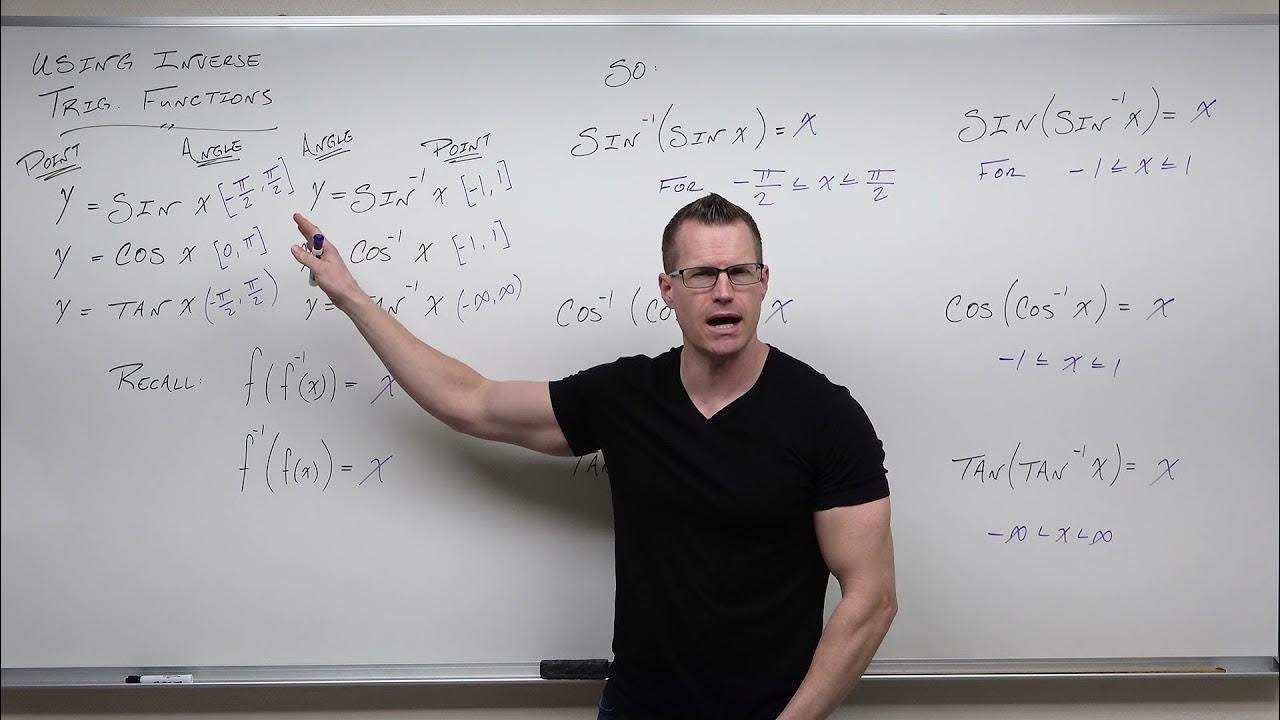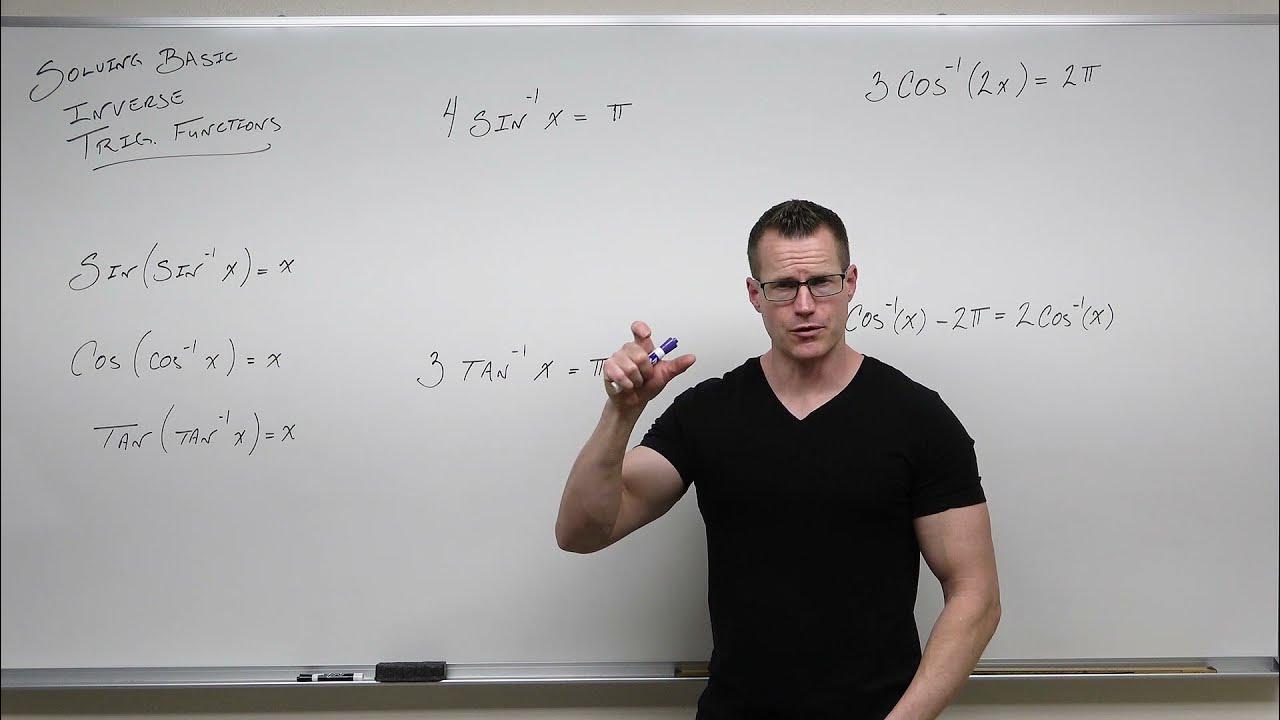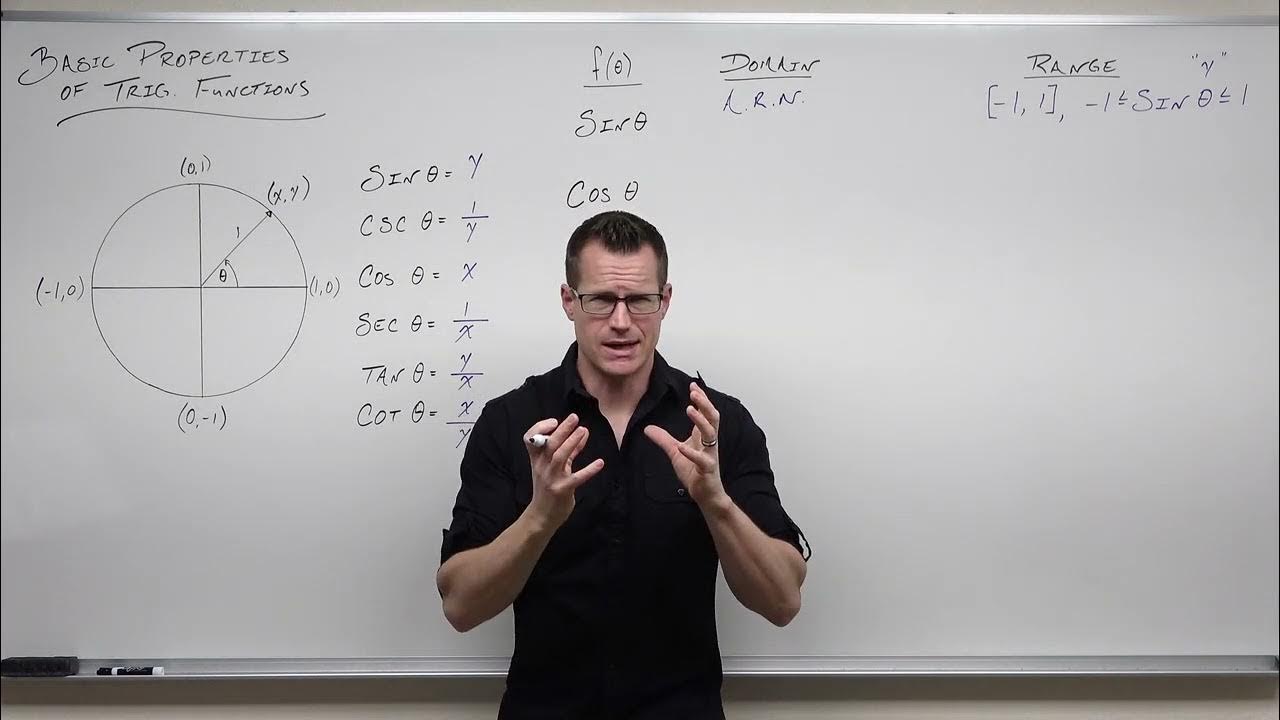Introduction to Inverse Trigonometric Functions (Precalculus - Trigonometry 17)
TLDRThis video script delves into the concept of inverse trigonometric functions, explaining why they are essential for solving equations involving trigonometric functions. The script clarifies that inverse functions are possible only for one-to-one functions, using the horizontal line test to determine if a function meets this criterion. It details how the sine, cosine, and tangent functions must be restricted to specific domains to become one-to-one and thus have inverses. The script walks through the process of finding the inverse functions for sine, cosine, and tangent, highlighting the switched roles of inputs and outputs, and the reflection of the original function's graph across the line y=x to obtain the inverse's graph. Key points and the transformation of domains and ranges for the original and inverse functions are also discussed. The explanation emphasizes the practical application of inverse trigonometric functions in solving equations and the conceptual reversal they represent on the unit circle, where inputs and outputs are interchanged compared to their original functions.
Takeaways
- 📐 **Inverse Functions and Trigonometry**: Inverse trigonometric functions are necessary to solve equations involving trigonometric functions because they allow us to reverse the operation, similar to how subtraction is the inverse of addition.
- 🤔 **Why Inverse Functions?**: We use inverse functions to solve for the angles in trigonometric equations when we know the lengths of the sides of a triangle.
- 👉 **One-to-One Functions**: A function has an inverse only if it is one-to-one, meaning each input corresponds to a unique output, allowing for a mapping in both directions.
- 🔄 **Horizontal Line Test**: The horizontal line test is a quick way to determine if a function is one-to-one; if any horizontal line intersects the function graph at more than one point, it's not one-to-one.
- ✂️ **Restricting the Domain**: For trigonometric functions like sine and cosine, which are not naturally one-to-one, we restrict their domains to specific intervals to create one-to-one functions.
- 📉 **Sine Function Restriction**: The sine function is restricted to the interval from -π/2 to π/2 to ensure it is one-to-one, allowing for the definition of the inverse sine function.
- 🔄 **Inverse Function Characteristics**: When finding an inverse function, inputs and outputs are switched, the domain and range are reversed, and the graph of the function reflects across the line y=x.
- 📌 **Key Points and Graphs**: Key points of the original function become key points of the inverse function after switching x and y values, and the graph of the inverse function is a reflection of the original graph across y=x.
- 🔢 **Domain and Range Switch**: For inverse trigonometric functions, the domain of the original function becomes the range of the inverse, and vice versa.
- ↔️ **Inputs and Outputs Reversed**: Inverse functions reverse the process such that the input to the original function becomes the output of the inverse function, and the output of the original function becomes the input to the inverse function.
- 🔧 **Practical Application**: Inverse trigonometric functions are used to find angles when the lengths of the sides of a triangle are known, which has practical applications in various fields like physics and engineering.
Q & A
Why are inverse trigonometric functions important?
-Inverse trigonometric functions are important because they allow us to solve equations that contain specific trigonometric functions, such as sine, cosine, and tangent. They are necessary when direct operations like addition or subtraction are not applicable due to the nature of trigonometric functions.
What does it mean for a function to be one-to-one?
-A function is one-to-one if each input is mapped to a unique output. This means that for every input value, there is a distinct and non-repeating output value. This property is essential for a function to have an inverse because it allows for a clear mapping in both the forward and reverse directions.
How can you determine if a function is one-to-one using the horizontal line test?
-The horizontal line test states that if a horizontal line intersects the graph of a function at more than one point, the function is not one-to-one. If there are no two points on the graph that have the same y-coordinate, then the function passes the test and is one-to-one.
Why is it necessary to restrict the domain of the sine function to create an inverse?
-The sine function is not one-to-one over its entire domain because it repeats its values every 2π. To create an inverse, the sine function must be restricted to a domain where it is one-to-one. The common restriction is from -π/2 to π/2, which ensures that each input value maps to a unique output value.
What is the domain and range of the sine function after it has been restricted to be one-to-one?
-After the sine function is restricted to be one-to-one, the domain becomes -π/2 to π/2, inclusive of the endpoints. The range remains the same as the original sine function, which is from -1 to 1, inclusive of the endpoints.
How do you find the inverse of a trigonometric function?
-To find the inverse of a trigonometric function, you first ensure that the function is one-to-one over a restricted domain. Then, you switch the roles of the input (x) and output (y), effectively reversing the function. This means the domain and range of the original function become the range and domain of the inverse function, respectively.
What is the relationship between the domain and range of a function and its inverse?
-The domain of the original function becomes the range of its inverse, and the range of the original function becomes the domain of its inverse. This switch is a direct result of the process of finding the inverse, where the inputs and outputs of the function are reversed.
What are the key points of the sine inverse function?
-The key points of the sine inverse function are when the input is -1, the output is -π/2; when the input is 0, the output is 0; and when the input is 1, the output is π/2.
How does the concept of inverse functions apply to the unit circle?
-On the unit circle, the input for the original trigonometric functions is an angle, and the output is a point on the circle. For the inverse trigonometric functions, this is reversed: the input is a point on the circle (or its coordinates), and the output is the angle that corresponds to that point.
What is the domain and range of the cosine inverse function?
-The domain of the cosine inverse function is from -1 to 1, and the range is from 0 to π. This is because the original cosine function has a range from -1 to 1 and a domain from 0 to π, which are switched for the inverse function.
Why is the tangent function already one-to-one over a certain interval without needing to restrict its domain further?
-The tangent function is already one-to-one over the interval from -π/2 to π/2 because it does not repeat its values within this interval. This is due to the function's nature of having vertical asymptotes at these points, which prevent multiple outputs for the same input within this range.
Outlines
😀 Introduction to Inverse Trigonometric Functions
This paragraph introduces the concept of inverse trigonometric functions, explaining their necessity for solving certain equations involving trigonometric functions. It emphasizes that inverse functions are needed because they allow us to 'reverse' the operation of a function, which is essential for solving equations. The paragraph also explains the 'one-to-one' property of functions that can have inverses, using the horizontal line test as a visual aid to determine if a function is one-to-one.
🔍 Restricting the Sine Function for Inverses
The second paragraph delves into the sine function's non-one-to-one nature and how it must be restricted to create a one-to-one function. It discusses why the full sine function cannot have an inverse and how by focusing on a specific interval (from -π/2 to π/2), we can define an inverse. The importance of this interval is highlighted, as it is the domain for the inverse sine function, and understanding this is crucial for students learning about inverse trigonometric functions.
🤔 Understanding Inverse Functions and Their Properties
This paragraph explains the properties of inverse functions in general. It clarifies that when finding an inverse, the inputs and outputs switch, as do the domain and range. The explanation includes a graphical representation, showing how the graph of an inverse function reflects across the line y=x. The paragraph also discusses how to solve for inverses by applying the inverse function to both sides of an equation.
📐 The Cosine and Cosine Inverse Functions
The fourth paragraph moves on to discuss the cosine function and its inverse. It points out that the cosine function is not one-to-one over its entire domain and must also be restricted for an inverse to exist. The interval from 0 to π is identified as the one-to-one portion of the cosine function, and the corresponding domain and range for the cosine inverse are established. Key points for the graph of the cosine inverse are identified, and the reversal of inputs and outputs is emphasized.
🤓 The Tangent and Its Inverse Function
The fifth paragraph examines the tangent function, which is already one-to-one over the interval from -π/2 to π/2, making it ready for an inverse without further restrictions. The domain and range of the tangent inverse are defined, and the key points for its graph are identified. The paragraph also discusses the change in asymptotes from vertical to horizontal when reflecting the graph of the tangent function across y=x.
📝 Conclusion and Future Topics
The final paragraph summarizes the process of restricting trigonometric functions to create one-to-one functions that can have inverses. It sets the stage for future videos that will cover how to use inverse trigonometric functions, including simplifying expressions and finding inverse functions for more complex trigonometric expressions.
Mindmap
Keywords
💡Inverse Trigonometric Functions
💡One-to-One Function
💡Horizontal Line Test
💡Domain and Range
💡Sine Function
💡Cosine Function
💡Tangent Function
💡Inverse Sine (arcsin)
💡Inverse Cosine (arccos)
💡Inverse Tangent (arctan)
💡Unit Circle
Highlights
Inverse trigonometric functions are essential for solving equations involving trigonometric functions.
Inverse functions are needed to reverse the operations of functions, similar to how subtraction is the inverse of addition.
A function has an inverse if and only if it is one-to-one, meaning each input corresponds to a unique output.
The horizontal line test is used to determine if a function is one-to-one; if a horizontal line intersects the graph more than once, it's not one-to-one.
The sine function is not one-to-one over its entire domain, so it must be restricted to create a one-to-one function.
The restricted domain for the sine function that allows for an inverse is from -π/2 to π/2.
Inverse sine (sin^(-1) or arcsin) is used to solve for angles in a right triangle when the side lengths are known.
When finding an inverse function, the domain and range switch, and the graph reflects across the line y=x.
The cosine function is also not one-to-one over its entire domain and requires a similar restriction for its inverse.
The domain for the cosine inverse (cos^(-1) or arccos) is from 0 to π, with a range of [-1, 1].
The tangent function is one-to-one on the interval from -π/2 to π/2, making it eligible for an inverse without further restrictions.
The domain and range of the inverse tangent (tan^(-1) or arctan) are all real numbers, reflecting the output of the tangent function.
Inverse trigonometric functions reverse the inputs and outputs of the original trigonometric functions, solving for the angle given the side lengths.
The concept of restricting domains to achieve one-to-one functions is crucial for the existence of inverses in trigonometry.
Understanding the relationship between the unit circle, angles, and coordinates is key to grasping the concept of inverse trigonometric functions.
Practical applications of inverse trigonometric functions include solving real-world problems involving triangles and periodic phenomena.
The video concludes with an introduction to using inverse trigonometric functions in expressions and solving for variables.
Transcripts
Browse More Related Video

How to Use Inverse Trigonometric Functions (Precalculus - Trigonometry 18)

Finding Inverse Functions (Precalculus - College Algebra 51)

Calculus 2 Lecture 6.5: Calculus of Inverse Trigonometric Functions

How to Solve Basic Inverse Trigonometric Functions (Precalculus - Trigonometry 20)

Inverse Trigonometric Functions

Basic Properties of Trigonometric Functions (Precalculus - Trigonometry 8)
5.0 / 5 (0 votes)
Thanks for rating: